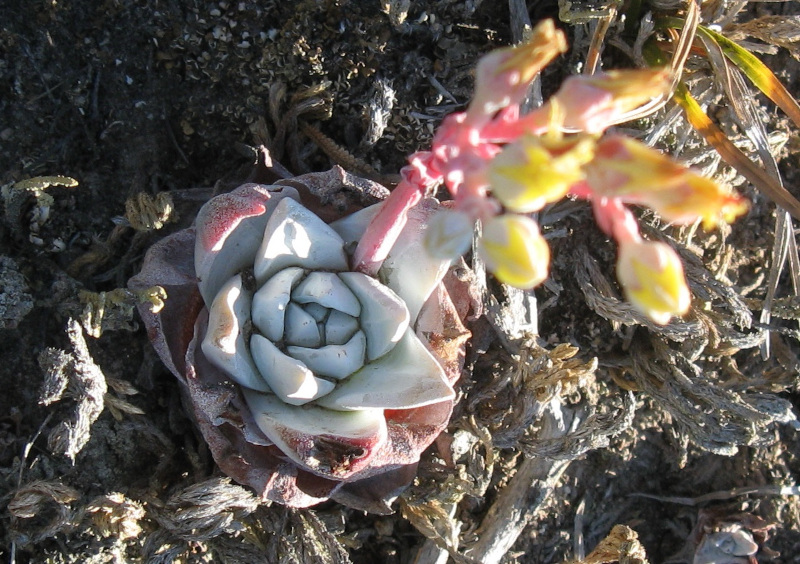
Munchkin liveforever Facts
- This intriguing creation of evolution frequently goes by the attention-grabbing moniker of Munchkin liveforever. The species does have other names, though. Some people also know it by the related, and almost as interesting, term of the munchkin dudleya.
- Among scientific professionals, however, it’s likely better known by its official name. The plant’s therefore bettern known by these experts by the name of Dudleya gnoma. Regardless of which one uses, it remains a species of some interest and note.
- The succulent owes that formal name to the respected American botanist, Stephen W. McCabe. This researcher accomplished the first official recognition of the plant as a separate and distinct species. That scientifically noteworthy feat ocurred in 1997.
- Unfortunately, the fascinating plant possesses both an extremely limited population and native range. Despite this lamentable fact, however, it does not currently appear on the Red List of Threatened Species. The IUCN could change that in the future, though.
- The stunning Munchkin liveforever does, however, appear on other official, specialized lists. These lists appear within the country the Angiosperm inhabits. The government of that country presently lists this botanical wonder as Critically Imperiled.
- This natural marvel continues to face several threats to its continued existence. Like most other species around the globe, it’s now endangered by ongoing climate change. Other, more highly localized threats include native deer and plant poachers.
Related Articles
Munchkin liveforever Physical Description
The visually distinctive Munchkin liveforever easily garners the attention of those fortunate enough to encounter it. It does not do so due to sheer size, however. That’s because, despite its other impressive attributes, it remains a comparatively small succulent.
That’s true since individual specimens rarely exceed 3.9 in (9.9 cm) in width. The small flowering stalk, technically known as a peduncle, also rarely attains a height greater than 5.12 in (13 cm). This upward grwoing feature typically branches no more than two times.
The main body of the Eudicot consists of tightly wound clumps of rosettes. These generally number between 1 – 24 on each specimen. Each of these further typically measures from 0.3 – 2 in (0.8 – 5 cm) in width. This portion of the plant usually manifests a varying pale shade.
The very same rosettes also most often develop around 20 leaves spread around the clump. These leaves generally display a white color, and have a fleshy, triangular shape. Each example of the remarkable foliage also presents a waxy, powdery coating which it exudes.
The flowers of the surprising Munchkin liveforever also garner a great deal of attention. Quantities vary from specimen to specimen, of course, but may total as many as 10. These develop at the ends of sterms so short they can be difficult to spot with the naked eye.
Its delicate blooms develop petals that appear a bright yellow in color. These measure from 0.31 – 0.35 in (8 – 9 mm) in length, and average 0.12 in (3 mm) in width. Each also produces sepals averaging 0.14 – 0.16 in (3.5 – 4 mm) long and 0.08 – 0.12 in (2 – 3 mm) wide.
- Kingdom: Plantae
- Phylum: Tracheophytes
- Class: Angiosperms
- Order: Saxifragales
- Family: Crassulaceae
- Genus: Dudleya
- Species: D. gnoma
Munchkin liveforever Distribution, Habitat, and Ecology
Sadly, the astounding Munchkin liveforever appears to have an extremely limited range of habitation. That’s due to the fact that the only known habitat of this plant comprises one single island. Even there, though, it only exists in one small, very specific area.
The succulent makes its home solely on part of Santa Rosa Island. This, in turn, forms part of the Channel Islands of California. This location naturally places it within the boundaries of the United States, in North America. There, it lives on a single ridge, on the eastern side.
It’s currently unknown, however, if it ever appeared anywhere else. The very nature of its habitat tends to restrict its possibility of expansion, though. Probably due to its isolation, it evolved to thrive best in an extremely specific, and uncommon, type of environment.
For its needs, it requires rocky soils, with a volcanic origin. Further complicating its opportunities for expansion is the fact that it also needs that soil to be relatively shallow in depth. Though it’s kept in cultivation by enthusiasts, this need renders it hard to maintain.
The marvelous Munchkin liveforever typically produces its colorful blooms between May and June. Pollination of those flowers occurs due to the actions of a wide variety of local insects. Like many such species, these include various species of bee, beetles, and others.
The distinctive name springs from the comparative longevity of individual specimens. Despite that, its entire population in the wild appears in only 3 small concentrations. The most recent count of its numbers by researchers numbered no more than 3,200 specimens.
Species Sharing Its Range
California Sheephead
Check out our other articles on 3 Manifestly Marvelous Macropods, European Honey Buzzard, Peacock Butterfly, Victoria Falls, Lau Banded Iguana, Jelly Ear, Australian Sea Lion
